Even though it’s an inconvenience, and might not save you that much money; make sure you know how to do the basics. Today I changed my oil; a very simple thing, that surprisingly few people know how to do these days. If you haven’t done it before then try it next time on your own; or with the aid of a friend who has done it before. You might have to throw a couple bucks into a tool or two; but that’s the worst of it.
Before you start look in your owner’s manual and find out how many quarts of oil you vehicle engine needs. The examples below are just examples.
You can walk into any store that sells oil filters and get what you need; so long as you know your cars year, make, and model (refer to the owner’s manual if you are not sure). Even Walmart has big books sitting around for you to thumb through.
Most people change their oil every 3,000 miles; my mother had thrown rods in two of her cars because she didn’t know how often she was supposed to do it.
Some people prefer to change their oil hot; but I don’t like burning myself of the exhaust pipe or engine block, or the hot oil for that matter; so I let it cool for an hour or two.
If you’re like me and don’t have fancy lifting equipment you can drive your passenger side wheels up on the curve in front of your house, and this should give you clearance to shimmy under your vehicle.
The Oils (from pennzoil.com):
Motor oil can be segmented into four basic varieties—synthetic oil, synthetic blends, high mileage oil and conventional oil.
Synthetic motor oil is a laboratory synthesis of precisely controlled ingredients created by oil engineers, scientists and chemists. When combined with a high-performance additive package, this results in an oil with the highest levels of lubrication and engine protection, generally offering better protection at startup, better cleansing qualities, enhanced durability and better protection against heat buildup.
Synthetic blend motor oils use a mixture of synthetic and conventional base oils for added resistance to oxidation (compared to conventional oil) and to provide excellent low-temperature properties and are recommended for cars, trucks, vans and SUVs that regularly carry heavy loads, tow trailers and/or operate frequently at high RPMs.
High-mileage motor oil is specially blended for older vehicles, or vehicles with higher mileage. Typically, 75,000 miles (120,000 kilometers) is the figure used regarding high mileage oil. Some high mileage, high-performance cars, however, will be better served by continuing to use a synthetic motor oil. That said, a special high mileage motor oil blend, with its unique additives and viscosity, helps reduce oil burn-off, helps in sealing oil leaks and helps improve combustion chamber sealing to help restore engine compression. It all adds up to enhanced performance in older engines.
Conventional motor oil is what its name implies—it uses base oils enhanced in the blending process with chemical additives to help meet the manufacturer’s desired levels of heat tolerance, breakdown resistance and viscosity (viscosity simply being a technical term for the thickness and fluidity of the oil). Conventional motor oil can be had in a range of viscosity grades and quality levels, from adequate to an extensively designed, high-quality lubricant. Conventional motor oil is recommended for drivers with low-mileage, late-model cars whose driving habits can be described as routine—commuting, running errands, vacation driving at relaxed cruising speeds. Today more and more engines require synthetic oil, so be sure to check your owner’s manual to make sure you don’t invite avoidable engine problems or void your warranty.
Oil Grade Designations:
Motor oils use a rating system developed by SAE, which is the Society of Automotive Engineers, to classify oil by viscosity. We’re all used to seeing designations like SAE 5W-30 or SAE 10W-30, so let’s talk about what they really mean.
For multi-grade viscosity oils, the cold-temperature viscosity is labeled with a “W,” which stands for “winter.” Thus, in an SAE 10W-30 oil, the “10” is the cold-temperature viscosity rating, and the “30” is the high-temperature viscosity rating. This combination provides an oil that flows well at low temperatures, but still protects the engine at high temperatures.
For comparison’s sake, SAE 5W-30 and SAE 0W-30 will flow better at even lower temperatures than 10W-30 while still providing protection at high temperatures. Just remember, the “W” stands for winter.
Please refer to your owner’s manual or our Oil Selector tool to ensure you are using the recommended motor oil for your vehicle.
Oil Pan Drain Plug:
From installuniversity.com: place your catch pan (make sure it will hold at least 6 quarts of fluid) to the side and out a little bit. Most car engines drain plugs use about a 15mm socket. When you remove the drain bolt the oil will flow out to the side a good ways. As the catch pan begins to fill up, the oil will begin to drain closer and closer back toward the oil pan. You might have to move your catch pan to adjust for this. Once the oil has drained out, retighten the oil pan drain bolt to 18 ft-lbs. We just tighten it up snug; don’t put a killer tight fit on it.
Oil Filter:
You might have to use a filter wrench to remove the oil filter. We just tighten our filter to “hand tight” so we don’t need a filter wrench to loosen our filter. When you go to loosen your filter, you are going to have some oil spill out. Just have your catch pan ready to catch the oil (and possibly the filter). Your filter will have oil already in it, so be careful not to tip the filter and cause a mess. Fill the “new” oil filter up with your “new” motor oil. Fill slowly and give the filter time to absorb the oil. This is not necessary but we like to prevent our oil pump from pumping air as much as possible. We highly recommend that you perform this step which is often referred to as “priming” your oil filter. While you are filling up the oil filter with oil, rub some clean oil around on the gasket of the oil filter. This will ensure a good seal and reduce the chance of ruining your gasket. This is just a good thing to do. Clean oil filter mounting surface on cylinder block. Coat rubber seal of new oil filter with engine oil.
Oil Filler Cap:
Locate the oil filler cap on your car. Take the cap off, stick your funnel inside the tube, and put the rest of the bottle of oil you used to fill the oil filter down the funnel. Then pour another four and one half quarts (just an example) down the hatch. Pour slowly; you don’t want to make a mess all over your engine block. Our car calls for five and one half (5.5) quarts of engine oil. Yours might take a little more (or a little less) and you will need to check this. Locate the oil dipstick and pull it out. Take a rag and wipe off the lower end of the stick. Notice the grooves and marking instructions on the dipstick? Go ahead and stick the dipstick back in and then pull it out again. You want the level to read in the full range. If it seems a little low, add a little oil at a time until you get just the right amount.
After I put the first few quarts it I usually give it a few minutes to settle for a more accurate reading on the dipstick. Re-wipe the dipstick every time you check the oil level.

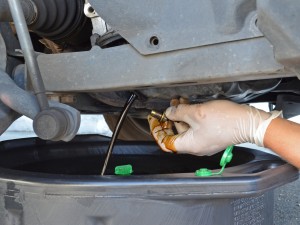
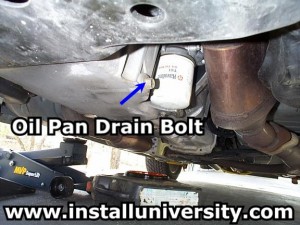
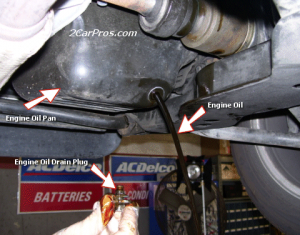
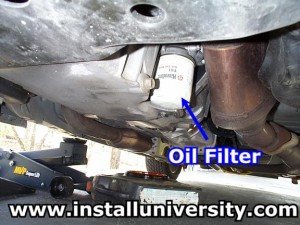
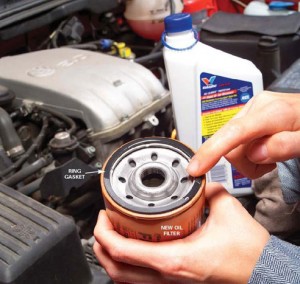
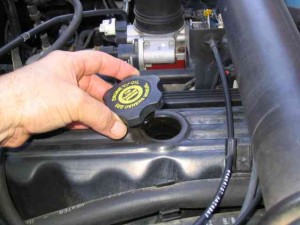
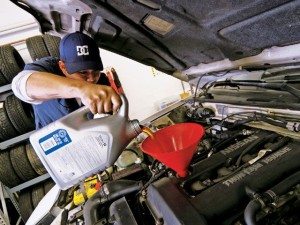
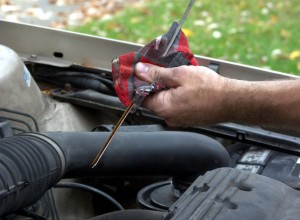
Knowing how to do an oil change for your car can help you save a lot. It is important to do it slowly in order to avoid getting messy. This simple car maintenance is a great way to improve the performance of your engine.
the first time I did it, I took the filter off before the plug and got oil all over myself. now days, I use my old oil for quenching when I’m firing up the forge and oiling some metal items in my shop that don’t need anything finer.